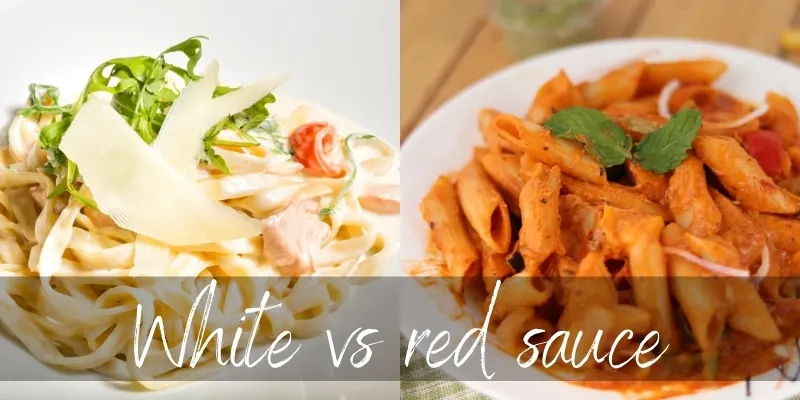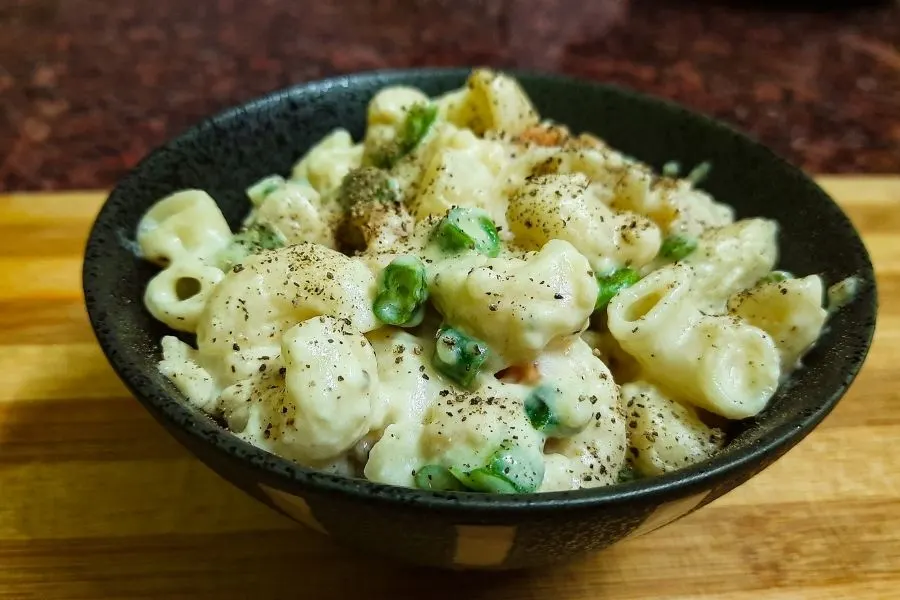Pasta sauce is always a tough choice: should you go for red or white pasta ? Both have their pros and cons, and it’s hard to settle on just one sauce. There are people who love both sauces and people who really can’t stand one or the other, so deciding on the one sauce can be really difficult.
This is where we come in. We’re going to take a close look at both white and red sauce, and compare the two. The majority of this post will talk about these sauces in relation to pasta, but you can easily use these for other meals, like a roast or a grill or just a salad.

White vs red sauce
White sauce is usually a much heavier, more decadent sauce than red sauce. White sauce often includes flour, butter, milk, and cheese in varying proportions, resulting in a high-calorie sauce.
Red sauce is usually tomato based and thus is a little acidic, ready to cut through very flavorful ingredients like red meat. Because of its ingredients red sauce tends to be lighter and also much less dense than white sauce.
White sauce is best paired with lighter flavors, since it’s pretty strong on its own.
What is white sauce ?
White sauce is any sauce that is white in appearance, though it usually has at least one of the following ingredients:
- flour, to thicken the sauce and it contributes to the white appearance
- milk or cream, to add flavor and help flour hydrate, also whitens the sauce
- butter, to add more flavor and substitute the cooking oil
- various cheese types, usually Parmesan, for flavor
You can also find white sauces with a bit of onion and/or garlic in them. This makes the overall flavor of a white sauce very, very heavy and decadent and it can completely drown out the rest of the ingredients. In pasta made with white sauce, the emphasis is on the sauce rather than the ingredients.
Due to its ingredients white sauce has the potential to be much higher in calories, as flour, cheese, butter, and milk all have considerably more calories than tomatoes and onions.

Read also: Should You Add Sugar To Pizza Sauce ?
What is red sauce ?
Red sauce is a tomato-based sauce that may also incorporate another red ingredient such as red bell peppers or chilies, and it’s often cooked with a good amount of onions. For pasta it’s the classic sauce, and most pasta dishes are formulated to rely on the acidity and flavor of th3e cooked tomatoes.
Some of the best red sauces are the ones cooked for several hours, to really meld all the flavors together. A common problem people have with red sauces is how acidic they can be, which can easily upset the stomach. The fact that tomatoes are a nightshade also doesn’t help the matter.
Red sauce is more acidic, pairs better with strong flavors
Because red sauce is tomato based, it’s more acidic and this can come in very handy when dealing with ingredients that are very rich. For example a beef-based pasta dish will benefit greatly from the sweet and acidic nature of red sauce, and once you add a bit of wine you can get an even better flavor.
Other ingredients that go well with red sauce are duck, pork, smoked meats, and mushrooms. These all pair well with red wine too.
White sauce is a different story, because it can get pretty strong-tasting on its own, depending on who is cooking it. Because of the higher fat and carb amount, white sauce can easily make bland ingredients taste more appealing.
Chicken or turkey breast is often paired with white sauce, though you can see smoked meats and mushrooms added here as well. In those cases a strong cheese or garlic is usually added.
White sauce is creamy, rich, and high in calories
White sauce relies on starch and fat to get a creamy consistency. The flour and the starch on the pasta make for a smooth, thick sauce while the fat in the butter and milk (or cream) add creaminess and depth of flavor. If you add some cheese like Pecorino Romano or Parmesan you get an even creamier sauce.
You also get a calorie-dense sauce, which may be counterproductive for those looking to shed some weight. All the carbohydrates and fats in a white sauce won’t work well towards losing weight.
Red sauce has no added starch, and the only fat is whatever cooking oil was added to the sauce. The rest of the ingredients are vegetables and the entire sauce is simmered for 2-3 hours. There are some calories in red sauce too, but much less than white sauce.
Red sauce may have red wine in it
The best tasting red sauce has a bit of re wine in it, and this is simply due to the extra layer of flavor the wine adds. This isn’t mandatory and you can easily make a great red sauce without a drop of wine. But if you have the wine and don’t have any medical reason to not use it, go ahead and add a small splash of red wine.
It will cook right along with the rest of the sauce and develop a deeper flavor. If you’re wondering if you can do this with white sauce, we’ve always found this to be a hit or miss. The wine can easily curdle the milk and you ca get a very odd tasting sauce.
Some cooks are amazing at adding white wine to white sauce, but we’re not those cooks. You can find them on Youtube though.
White sauce may end up thicker than red sauce
Due to white sauce’s ingredient list it can easily end up too thick and sometimes even clumpy. When you boil a pot of pasta, the starch in it activates and they become sticky. Any sauce you add over cooked pasta will absorb some of that starch, and the more you toss the pasta around the thicker the sauces gets from all that starch.
If you do this with white sauce, you have to keep the white sauce intentionally soupy, so it thickens as you toss the pasta and cook it in the sauce. If your white sauce is at the right consistency before you add the pasta, it will get too thick once you’re done cooking.
Red sauce relies on the starch present on the cooked pasta to get it a bit thicker. It can be thick on its own too, because of the cooked tomatoes and onions. But it has no natural starch, meaning it won’t easily cling to the pasta.
You can do a combination sauce
If you can’t decide between the two sauces you can always do a combo sauce. The base can be either the red or white sauce, and you add another ingredient from the other list. Here’s a short breakdown, according to which sauce you use for the base.
When using a red sauce base, you may add cream and a bit of butter, or some Parmesan. Do not add milk directly since it’s too liquid and your sauce will be too runny. You may also thicken this sauce with a bit of flour if you want, though we don’t recommend that. In this kind of sauce it’s best to only add some cream to mellow out the tomato sauce, and let it simmer for another couple of minutes.
When using a white sauce base you can make your white sauce as usual, only add a tablespoon or two of tomato sauce. You can swap the tomato sauce for roasted bell peppers if you want.
Try out different sauces for your pastas
If you’re feeling like red or white pasta sauce is too simple minded, there are plenty of other sauces to choose from. Below we’ve compiled a list of sauces you can add to your pasta to make things more interesting. If you’re reading this for pizza sauces, keep in mind that not all of these may work well in a hot oven.
Pesto, a green basil-based sauce
Pesto is a deep green sauce that jus screams fresh basil at you. You either love it or hate it, there is no in-between. This one works great with light meats such as chicken breast or fish or any type of seafood.
If making a veggie-based dish pesto can really round out the flavor and provide a better looking sauce than red or white.

Squid ink sauce, indigo-black
Squid ink sauce requires actual squid ink, and you will only find that in freshly caught squid. Each squid has a sac filled with ink that is easy to find and remove from the squid. You can add the ink to the pasta sauce, but be sure to cook it for a couple of minutes.
It brings a tangy taste, and has a fresh seafood flavor to it. Needless to say this kind of sauce pairs best with actual seafood.
Brown sauce, leftover from a roast
You can use the leftover brown sauce from a roast, and your pasta will go great with anything. We recommend a veggie base because you’ll get plenty of meaty flavor from the brown sauce. If you want to add some meat to it be our guest, the result is always going to be great. Peas go particularly well with this sauce, as an add-in.
No sauce, just fresh Parmesan and olive oil
You can do things a bit simpler and just forego the sauce, instead relying on the olive oil and a bit of pasta water to create an emulsion. You can grate some fresh Parmesan on the side and mix it into the pasta when everything is ready. This way you get a creamy, rich pasta without cooking a pot of sauce.

